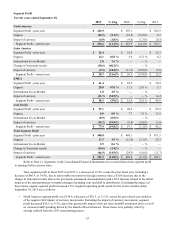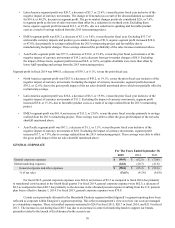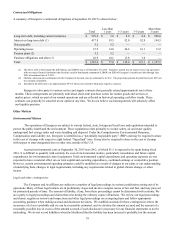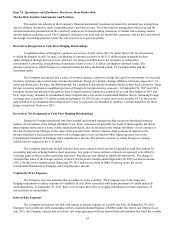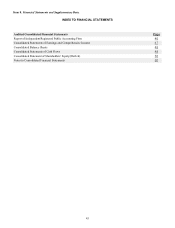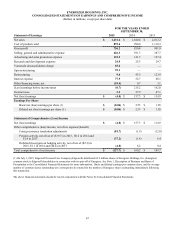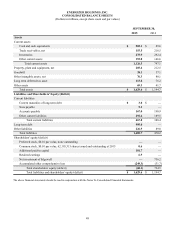Energizer 2015 Annual Report Download - page 45
Download and view the complete annual report
Please find page 45 of the 2015 Energizer annual report below. You can navigate through the pages in the report by either clicking on the pages listed below, or by using the keyword search tool below to find specific information within the annual report.41
presented. Actual costs that would have been incurred if Energizer had been a standalone company would depend on
multiple factors, including organizational structure and strategic decisions made in various areas, including
information technology and infrastructure.
• Revenue Recognition – Energizer’s revenue is from the sale of its products. Revenue is recognized when title,
ownership and risk of loss pass to the customer. Discounts are offered to customers for early payment and an estimate
of the discounts is recorded as a reduction of net sales in the same period as the sale. Our standard sales terms are final
and returns or exchanges are not permitted unless a special exception is made. Reserves are established and recorded
in cases where the right of return does exist for a particular sale.
Energizer offers a variety of programs, such as consumer coupons and similar consumer rebate programs, primarily to
its retail customers, designed to promote sales of its products. Such programs require periodic payments and
allowances based on estimated results of specific programs and are recorded as a reduction to net sales. Energizer
accrues, at the time of sale, the estimated total payments and allowances associated with each transaction.
Additionally, Energizer offers programs directly to consumers to promote the sale of its products. Promotions which
reduce the ultimate consumer sale prices are recorded as a reduction of net sales at the time the promotional offer is
made, generally using estimated redemption and participation levels. Taxes we collect on behalf of governmental
authorities, which are generally included in the price to the customer, are also recorded as a reduction of net sales.
Energizer continually assesses the adequacy of accruals for customer and consumer promotional program costs not yet
paid. To the extent total program payments differ from estimates, adjustments may be necessary. Historically, these
adjustments have not been material.
• Pension Plans - The determination of the Company’s obligation and expense for pension benefits are dependent on
certain assumptions developed by the Company and used by actuaries in calculating such amounts. Assumptions
include, among others, the discount rate, future salary increases and the expected long-term rate of return on plan
assets. Actual results that differ from assumptions made are recognized on the balance sheet and subsequently
amortized to earnings over future periods. Significant differences in actual experience or significant changes in
macroeconomic conditions resulting in changes to assumptions may materially affect pension obligations. In
determining the discount rate, the Company uses the yield on high-quality bonds that coincide with the cash flows of
its plans’ estimated payouts. For the U.S. plans, which represent the Company’s most significant obligations, we
consider the Mercer yield curve in determining the discount rates.
Of the assumptions listed above, changes in the expected long-term rate of return on plan assets and changes in the
discount rate used in developing plan obligations will likely have the most significant impact on the Company’s annual
earnings, prospectively. Based on plan assets at September 30, 2015, a one percentage point decrease or increase in
expected asset returns would increase or decrease the Company’s pre-tax pension expense by approximately $6.4. In
addition, poor asset performance may increase and accelerate the rate of required pension contributions in the future.
Uncertainty related to economic markets and the availability of credit may produce changes in the yields on corporate
bonds rated as high-quality. As a result, discount rates based on high-quality corporate bonds may increase or decrease
leading to lower or higher, respectively, pension obligations. A one percentage point decrease in the discount rate
would increase pension obligations by approximately $88.7 at September 30, 2015.
As allowed under GAAP, the Company’s U.S. qualified pension plan uses Market Related Value, which recognizes
market appreciation or depreciation in the portfolio over five years so it reduces the short-term impact of market
fluctuations.
• Share-Based Payments – The Company grants restricted stock equivalents, which generally vest over two to four
years. Stock compensation expense is measured at the grant date based on the estimated fair value of the award and is
recognized on a straight-line basis over the full restriction period of the award.
• Income Taxes – Our annual effective income tax rate is determined based on our income, statutory tax rates and the
tax impacts of items treated differently for tax purposes than for financial reporting purposes. Tax law requires certain
items be included in the tax return at different times than the items are reflected in the financial statements. Some of
these differences are permanent, such as expenses that are not deductible in our tax return, and some differences are
temporary, reversing over time, such as depreciation expense. These temporary differences create deferred tax assets
and liabilities.






